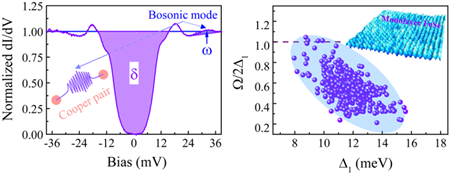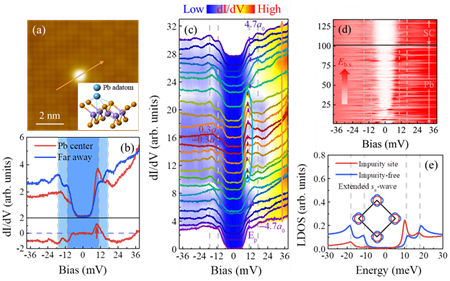Peking University, July 19, 2019: Recently, Professor Wang Jian and collaborators reported the observations of magnetic-excitation-like bosonic mode and quasiparticle bound states induced by strong nonmagnetic impurities in one-unit-cell (0.55 nm) iron selenide (FeSe) epitaxially grown on strontium titanate (SrTiO3). The findings provide strong evidence for the sign-reversing pairing in one-unit-cell FeSe film, suggesting that, despite of electron−phonon coupling that is commonly believed to enhance superconductivity, spin fluctuations are nonnegligible in mediating the Cooper pairing in one-unit-cell FeSe. These results combined together are significant ingredients in a unified understanding of the high-temperature superconductivity in iron-based superconductors.
Improving the superconducting transition temperature and understanding the Cooper-pairing mechanism are two of the most important research directions in the field of superconductivity. In previous studies on iron-based superconductors, the s±-wave pairing based on electron−hole Fermi-pocket nesting has been widely accepted. However, in heavily electron-doped iron selenides, e.g., AxFe2−ySe2 (A = K, Rb, Cs, Tl), (Li1−xFex)OHFe1−ySe, especially one-unit-cell FeSe/SrTiO3, the heavy electron doping will shift the Fermi level upwards, which leads to the hole Fermi pocket at Brillouin-zone center falling below the Fermi energy, eventually leaving the electron−hole Fermi-pocket nesting theory conceptually irrelevant. Therefore, the s± pairing scenario in iron-based superconductors is severely challenged. Alternative pairing symmetries were theoretically proposed, including plain s++-, anisotropic s++-, orbital-fluctuation–mediated s++-, odd-parity s-, ‘hidden’ s±-, extended s±- and nodeless d-wave.
One-unit-cell FeSe film epitaxially grown on SrTiO3 possesses the simplest structure and the highest superconducting transition temperature (the gap-closing temperature is typically 65 K) in iron-based superconductors. Since the discovery in 2012 by Professor Xue Qi-Kun’s team, such interfacial system has attracted tremendous research interest in condensed-matter physics. Previously, by electrical-transport and magnetic-susceptibility measurements, Wang group at Peking University and Xue group at Tsinghua University firstly reported the direct evidence for high temperature superconductivity in one-unit-cell FeSe [Chin. Phys. Lett. 31, 017401 (2014) with an Editors’ Choice paper, Science 343, 230 (2014)]. However, the superconducting pairing mechanism therein has remained unresolved.
To further uncover the the superconducting pairing mechanism, Wang group carried out a serials of experiments. The one-unit-cell FeSe ultrathin film was epitaxially on a SrTiO3(001) substrate by molecular-beam epitaxy. By in situ scanning tunneling spectroscopy, a ‘dip−hump’ structure induced by electron−boson coupling was detected in the tunneling spectrum beyond the superconducting gap. Systematic scanning-tunneling-spectroscopy experiments reveal that the hump-typified boseonic mode is a magnetic-like excitation in nature (Fig. 1). Thus, most likely the pair-‘gluing’ (π , π) is spin fluctuations that nest the sign-reversing electron Fermi sheets at adjacent M points. Being complex in nature, the superconducting order parameters can be either in-phase (sign-preserving) or anti-phase (sign-reversing) over the Fermi surface. As a phase-sensitive technique, impurity scattering has been widely used in previous studies on superconducting pairing. The nonmagnetic impurities are particularly important, which selectively destroy only the sign-reversing pairings, e.g., s±-, and d-wave, via phase decoherence and/or pairing-magnitude suppression by in-gap quasiparticle bound states, but show little influence on the conventional s-wave pairing. The magnetically selective impurity effects on superconductivity make nonmagnetic scatterings capable to distinguish sign-preserving and sign-reversing pairings. By using the strong nonmagnetic impurities lead (Pb) deposited on one-unit-cell FeSe as the scatterers, Wang group found the Pb adatoms induced electron-like spectral-weight enhancement near the gap edge and superconducting-gap suppression relative to the normal superconducting spectral lineshape (Fig. 2). These spectral-reconstruction features are typical signals of the ‘hidden’ bound state. More systematic experiments, like fine tuning of the scattering potential [Fig. 2(d)], also confirmed this point of view, which strongly suggests the existence of sign reversal in the superconducting-gap function of one-unit-cell FeSe. Additionally, within the framework of sign-reversing pairing, e.g., extended s±-wave [Fig. 2(e)], Professor Wang Qiang-Hua from Nanjing University and Professor Gao Yi from Nanjing Normal University theoretically reproduced the nonmagnetic-impurity-induced spectral reconstruction qualitatively.
The findings of the two studies mentioned above, i.e., bosonic mode and nonmagnetic scatterings, consistently support the spin-fluctuations-mediated sign-reversing pairing in one-unit-cell FeSe, which are both essential for finally clarifying the interface high-temperature superconducting mechanism of one-unit-cell FeSe. The studies also indicate that the iron-based superconductors with different Fermi-surface topologies may share a unified interpretation.
The two works were published on May 22, 2019 and July 15, 2019 in Nano Letters [Nano Lett. 19, 3464−3472 (2019)] and Physical Review Letters [Phys. Rev. Lett. 123, 036801 (2019)], respectively. Links to the papers: https://pubs.acs.org/doi/10.1021/acs.nanolett.9b00144, https://journals.aps.org/prl/abstract/10.1103/PhysRevLett.123.036801.
For Nano Letters paper, Professor Wang Jian at Peking University is the corresponding author, and Liu Chaofei at Peking University is the first author. For Physical Review Letters paper, Professor Wang Jian at Peking University and Professor Wang Qiang-Hua at Nanjing University are the corresponding authors, and Liu Chaofei and Wang Ziqiao at Peking University, and Professor Gao Yi from Nanjing Normal University contributed equally to this work.
These works were financially supported by the National Natural Science Foundation of China, the National Key R&D Program of China, Collaborative Innovation Center of Quantum Matter, Strategic Priority Research Program of Chinese Academy of Sciences, Beijing Natural Science Foundation, and Natural Science Foundation from Jiangsu Province of China. Wang Jian would like to thank Xie X. C. , Wang Fa, Xu Limei, Ren Zefeng and Collaborative Innovation Center of Quantum Matter for the support on the ultrahigh-vacuum molecular-beam epitaxy and low-temperature scanning tunneling microscopy (UHV MBE−LT STM) system.

Figure 1. Bosonic mode with signatures of magnetic excitation in one-unit-cell FeSe. (a) Tunneling spectrum of one-unit-cell FeSe, showing the ‘hump’ structure outside the superconducting gap induced by electron−boson coupling. (b) Statistical anticorrelation between Ω/2Δ1 and Δ1 (Ω: bosonic-mode energy ; Δ1: inner superconducting-gap energy).

Figure 2. Quasiparticle bound states induced by strong nonmagnetic impurities in one-unit-cell FeSe. (a) STM topographic image of Pb adatoms. (b) Tunneling spectra of Pb adatom and ‘normal’ one-unit-cell FeSe, showing a ‘hidden’ bound state at 9.5 mV. (c) Spatially resolved tunneling spectra taken across the Pb adatoms. (d) False-color plot of the tunneling spectra of 101 Pb adatoms (below the black line). The spectra from bare 1-UC FeSe surface are plotted for comparison (above the black line). (e) Simulated local density-of-state spectrum upon a nonmagnetic impurity within extended s±-wave pairing scenario.
Edited by: Zhang Jiang
Source: School of Physics

